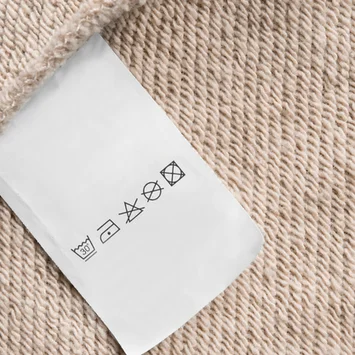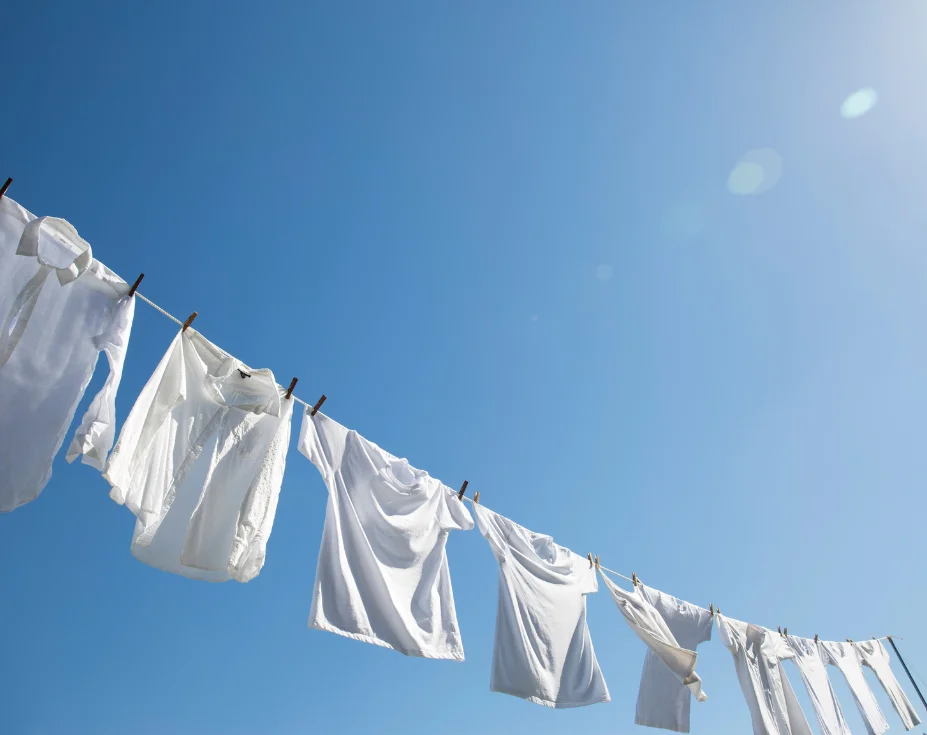Wash laundry properly: The best tips for clean clothes
A well-cared for and properly washed wardrobe not only looks better, but also lasts longer. But doing laundry is more than just filling the washing machine and selecting a program. In this article, you will find the best tips and tricks for washing correctly so that your clothes always stay clean and in shape.
From preparation and choosing the right detergent to caring for delicate fabrics - here you can find out how to avoid typical mistakes and ensure perfect washing results.
Preparation for washing
Careful preparation is essential before we start the washing machine. This includes sorting the laundry, following the care instructions and pretreating stains. These steps help to prevent discoloration and damage and ensure the cleanliness of the laundry.
Pre-treat stains
Stains should always be treated before the actual wash cycle to achieve the best results. For heavily soiled laundry, it may also be a good idea to soak it overnight before washing.
Properly sorting laundry is the first and one of the most important steps. Colors, materials, and washing temperatures should be considered to avoid discoloration and damage. White laundry should be washed separately, as well as delicate materials such as silk or wool. This ensures that each garment receives the appropriate care.
Follow care instructions
The care labels on your clothing are your best friends when it comes to choosing the right washing treatment. These symbols provide important information about washing temperature, appropriate wash cycle, and drying method. Different textile fibers such as virgin wool, silk, and leather require special care to ensure their longevity.

Choosing the right detergent
Selecting the right detergent is the foundation for cleanliness and care of your clothes. But when should you use powder, capsules, or liquid detergent? Each type has its own advantages and disadvantages. We present the different types of detergents and the correct dosage.
Types of detergents
There are three main types of detergent:
-
Powder, which is particularly suitable for white and non-delicate colored laundry, as it provides better washing performance.
-
Liquid detergent, ideal for colored clothes at low temperatures, as it leaves no residue.
-
Capsules, which are convenient to use but often more expensive.
For delicate materials like wool, a special wool detergent should be used to protect the fibers. When choosing a detergent, it's always important to consider the needs of the fabric.
Dosage of detergents
The correct dosage of detergent is crucial for clean laundry and environmental protection. Overdosing can lead to detergent residues that may cause skin irritation. At the same time, more detergent does not automatically mean cleaner laundry. It is important to follow the dosage instructions on the packaging and correctly assess the level of soiling.
Errors in dosage cause the greatest environmental impact from detergents. Proper dosing can reduce this impact, which benefits both the environment and your wallet.
Fabric softener: Yes or no?
The use of fabric softeners is controversial. On the one hand, they make laundry soft and give it a pleasant scent. On the other hand, they can damage the fibers of the clothes and are often not environmentally friendly.
If you still don't want to give up fabric softener, you should use products without perfume and with essential oils. A few drops of essential oil shortly before the end of the wash cycle can also provide a pleasant scent without harming the environment.
The right wash program
Selecting the appropriate wash program is the foundation for cleanliness and the longevity of your textiles. There are various wash programs for different needs, from standard programs to special ones and environmentally friendly eco programs.
Standard programs
Standard programs like colored wash and easy care are suitable for most everyday clothing. The colored wash program uses temperatures between 30 and 60 degrees Celsius and is ideal for sturdy cotton garments.
The easy care program, on the other hand, uses reduced drum movements and lower temperatures to gently clean delicate textiles.
Special programs
For particularly delicate fabrics such as wool and silk, there are special programs like the hand wash and wool wash cycles. These programs provide especially gentle treatment by significantly reducing movement inside the washing machine. The delicate wash program is ideal for sensitive items like blouses and dresses.
Eco programs
Eco programs are environmentally friendly and reduce energy consumption by extending the cycle duration. They avoid high temperatures and prolong the soaking time to save energy. These programs can take between two and a half to five hours, but consume significantly less energy.

Drying the laundry
After washing, the question arises of how to dry the laundry. Learn about the advantages and disadvantages of air drying, indoor drying, and using a tumble dryer.
Air drying
Air drying is one of the most environmentally friendly methods for drying laundry. It saves energy and is gentle on fabrics. However, air drying can make laundry feel stiffer, which actually has a positive massaging effect on the fibers. To avoid wrinkles, textiles should be shaken out and hung up smoothly after washing.
Delicate fabrics such as wool should be dried flat to preserve their shape. More durable garments, on the other hand, can be hung up while damp. Space-saving drying rack models are ideal for small spaces and can be stored away easily.
Tumble dryer
A tumble dryer can be especially useful when time is short or for durable materials and home textiles like towels and bed linens. However, using a tumble dryer is not always advisable, especially for delicate fabrics that could be damaged. Delicate laundry such as wool and silk should be gently reshaped and dried flat.
When purchasing a tumble dryer, it's important to consider the different models and their features to find the right one for your needs. Energy-efficient models are recommended, as they help reduce electricity consumption.
Indoor drying
When drying laundry indoors, it is important to pay attention to air circulation, room temperature, and humidity. This helps prevent mold growth and musty odors. Damp laundry can start to smell and develop mold, especially if dried in cold and poorly ventilated rooms.
To prevent these issues, damp towels and sweaty sportswear should be air-dried first before being placed in the laundry basket. Additionally, dry laundry should be put away in the closet as soon as possible to avoid wrinkles and musty smells.

Ironing and Storage
Proper ironing and storage of laundry helps extend its lifespan and ensures that clothing always looks well cared for.
Ironing tips
Delicate fabrics require special techniques when ironing, including the correct temperature and method. Silk, for example, should be ironed at setting two, slightly damp, and without steam. Polyester should only be ironed at a low temperature and inside out to avoid melting the fibers.
It is also important to regularly clean the iron to prevent buildup that could damage delicate fabrics. A clean iron ensures even heat distribution and prevents stains on clothing. When ironing particularly delicate fabrics like chiffon or lace, use a pressing cloth to avoid direct contact with the iron. This protects the fine fibers and preserves the fabric’s structure.
For materials like linen or cotton, which tend to wrinkle more, it can be helpful to spray a bit of water or use a steam iron to smooth out creases more easily. Be sure to hang or lay the garments flat immediately after ironing to prevent new wrinkles from forming.
It is beneficial to iron garments slightly damp, as this makes the process easier. Viscose should also be ironed inside out and slightly damp, and the steam function can be used.
Storing laundry
Proper storage of clothing in the wardrobe helps prevent wrinkling and damage. Hang delicate garments on padded hangers and store heavy clothing flat to maintain its shape.


